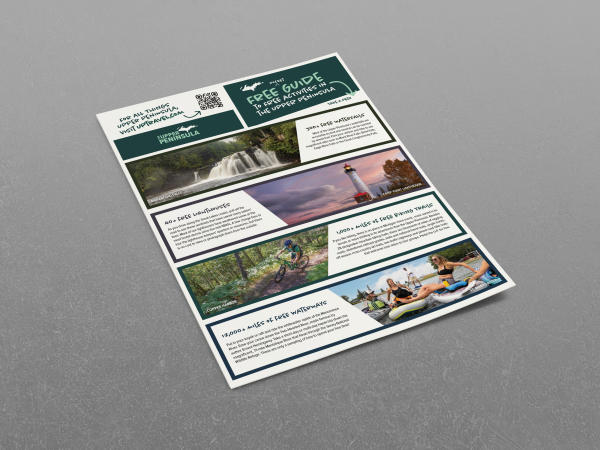Watching the Northern Lights or Aurora Borealis shimmer and dance across the horizon is one of the most thrilling experiences in a lifetime. Many people, however, never see them because they think they must travel to Alaska, Canada, Finland, Norway or the North Pole. Yet, some of the best viewing is here in Michigan’s Upper Peninsula.
WHAT ARE THE NORTHERN LIGHTS
The dazzling swirls of greens, purples, oranges and reds occur when sun particles, riding on the solar wind, collide with Earth’s atmosphere. It’s not an every-night event.
WHEN IS THE BEST TIME TO SEE THE LIGHT SHOW
Catching a glimpse of these celestial dances is best in the U.P. between August and April. What days they occur hinges on understanding solar flares and the KP Index, which forecasts geomagnetic activity.
You can peek at the forecast and tailor your adventure by paying attention to these forecasting sites:
When the KP Index is in the 0-2 range, the Aurora Borealis will be farther north, quite dim in intensity, and not very active. But when the index gets to the 3-5 range, the Northern Lights move farther from the poles and explode in color and motion.
THE UPPER PENINSULA’S FIVE BEST VIEWING LOCATIONS ON LAKE SUPERIOR
The Upper Peninsula is ideal for seeing the Northern Lights because it has little to no light pollution. Lake Superior also offers miles of unimpeded views of the horizon and night sky. It is closer to the North Pole than other parts of Michigan, so the days are shorter and the nights are longer from fall through mid-April. This lets you stargaze in the early evenings.
You can watch the Northern Lights anywhere in the U.P. where there is a clear spot on Lake Superior’s southern shore.
Here are five of the top picks for viewing along Lake Superior.
1. Brockway Mountain, Keweenaw International Dark Sky Park, Copper Harbor
The Keweenaw Dark Sky Park is one of only three parks in Michigan and about 100 in the world to complete the robust international dark sky certification process. The park is free and headquartered at the historic Keweenaw Mountain Lodge, 4252 U.S. Highway 41, Copper Harbor.
One of the best places in the U.P. to watch the Northern Lights is Brockway Mountain Drive. You will gasp at the view from 735 ft. above lake level. The experience of looking out at Lake Superior is otherworldly!
The paved road is open from mid-April until snow closes it. In winter, you can access the spectacular view via a snowmobile.
2. Miners Castle, Pictured Rocks National Lakeshore, Munising
One of the most famous landmarks in this highly-visited national park is Miners Castle. It is the only cliff area accessible by car. A short paved, wheelchair-accessible path takes you to the overlook for viewing the Northern Lights. Access to this lookout and other viewing beaches may be limited by snow in the winter, so you may need to reach them by snowmobile, cross-country skis or snowshoes.
3. M-28 Turnouts Between Munising and Marquette
Head west from Munising on Highway M-28 to Marquette. This road snugs up to the Lake Superior shore. There are several turnouts where you can pull off to watch the Northern Lights and see more stars than you can count.
4. Breakers Beach, North Canal Township Park, Houghton
This beach, called the “Breakies” by locals, is 11 miles from downtown Houghton. The beach is outside the breakwall, facing Lake Superior’s open water. It has several campfire rings to roast hot dogs, marshmallows or campfire fare. Bring firewood, matches and chairs. Bundles of wood are available for purchase at several firewood stations on the way into the park — bring cash. There is plenty of parking, but arrive early on Northern Lights nights — the sky show draws a crowd.
5. Eagle Harbor Lighthouse, Eagle Harbor, Keweenaw Peninsula
If you have been to the coast of Maine, this picturesque harbor and lighthouse on Lake Superior will remind you of it. Arrive early enough on a clear day to watch the sunset before being mesmerized by the Northern Lights. Have your camera ready for both.
OTHER FAVORITE LOCATIONS ALONG LAKE SUPERIOR
WHAT TO WEAR AND BRING WHEN STARGAZING
Dress for the weather, remembering that it will be colder along the shores of Lake Superior. Wear a warm coat, boots, hat and gloves. Bring a portable chair or blanket plus a red-light flashlight to protect your night vision, binoculars, a telescope and a camera. Pack some snacks and a warm beverage. Then sit back and be awed!
BOOK YOUR STAY NOW!
Whether you’re seeking adventure, relaxation, or a bit of both, the U.P. has something special for every stargazing traveler. To get the Northern Lights dates you want, book your stay early.
A FREE U.P. POCKET GUIDE TO FREE ACTIVITIES

Share with Us
We would love to see your Northern Lights photos! Use our hashtag #uptravel for an opportunity to be featured on our social media, website or in our marketing materials. You can also upload your photos to our Northern Lights Photo Crowdriff Collector below.
